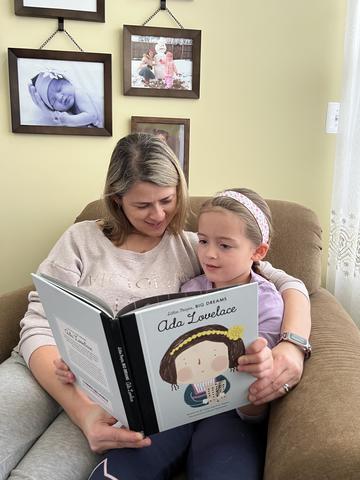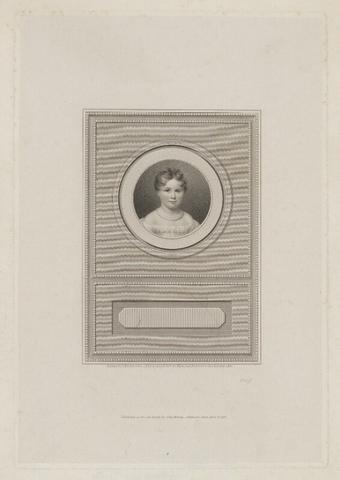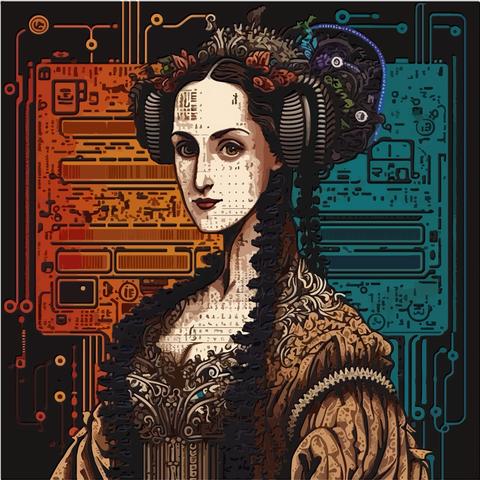Taking Measure
Just a Standard Blog
Ada Lovelace: The World’s First Computer Programmer Who Predicted Artificial Intelligence

NIST researcher Justyna Zwolak is teaching her young daughter about important women in science and math, including Ada Lovelace.
Ever since she was just a toddler, my daughter has been curious about the world around her, always ready to ask all the “why” and “how” questions. When she was in kindergarten, she started watching Ada Twist, Scientist — an animated show about a little girl curious about everything science.
I thought it could be fun to talk to my daughter about real female scientists.
Since I am Polish, Maria Skłodowska-Curie, also known as Marie Curie, was the natural first choice for me. As I was browsing through children’s books, I discovered that there was also one about another scientist who was just as close to my heart — Ada Lovelace. I got both books.
As I read the book about Lovelace to my daughter, Gabi, I told her about how Lovelace was a little like me. She had a love for mathematics and a belief that computers can be used to automate many of the laborious tasks humans do. The latter is actually my main research focus.
I told Gabi about how the work Lovelace did almost 200 years ago is still very relevant to what I do now every day. That was a very special experience to share with my daughter.
During Women’s History Month, I am remembering Lovelace’s contributions to the field and thinking about the impact she had on me as a scientist and mathematician.
Today, computers are such an integral part of our daily lives; we can’t imagine not being able to use them to solve nearly any problem or answer any question.
The idea that computing machines can go beyond just calculating numbers and be used to perform any abstract operation is the defining phenomenon of our technology.
However, not everyone knows that this idea of universal computation dates to long before the first programmable, general-purpose digital computer was introduced in the 1940s.
This concept goes back to the 1800s, thanks to Lovelace, a pioneer in mathematics and computing.
Lovelace’s Early Life Led to a Passion for Mathematics

Augusta Ada King, the Countess of Lovelace, was born in London on Dec. 10, 1815. She’s most well known as Ada Lovelace. Her parents were the English poet Lord Byron and Lady Anne Isabella Milbanke.
After her parents’ marriage ended, Lovelace had an isolated childhood at the country estate of her grandparents, where her mother moved after leaving London. Lovelace’s grandmother enforced a strict system of education for Lovelace. She appointed a personal governess to teach the little girl history, literature, languages, geography, music, chemistry, sewing, mathematics and horse riding. Unfortunately, her studies were abruptly interrupted when, around the age of 13, she got sick with measles and ended up bedridden and in poor health.
As a teenager, Lovelace went to London with her mother, where she attended many parties. One of them was held at the house of a 41-year-old mathematician, philosopher and inventor, Charles Babbage.
Babbage, impressed by the 17-year-old’s knowledge of mathematics, invited her, with her mother as a chaperone, to come back the next day for a demonstration of his newly constructed prototype of an automated mechanical calculator he had created, known as the small difference engine. This machine used only addition and subtraction, but it could do complex calculations and print results as a table.
This ignited Lovelace’s interest in mathematics even more, and she began corresponding with Babbage while also continuing her studies.
Lovelace Returned to Her Passion for Mathematics After Marriage and Motherhood
In the spring of 1835, Lovelace met William King, an open-minded and gregarious man. They married a few months later. Over the next several years, she managed a large household and had three children, which took up most of her time.
Within a few months of the birth of her third child in 1839, Lovelace decided to get more serious about mathematics again. She began to study under the supervision of Augustus De Morgan, a professor of mathematics at University College London.
Lovelace also continued to interact with Babbage, who traveled to Turin, Italy, to deliver lectures on his new invention, the analytical engine.
Although Babbage himself never published anything about his analytical engine, professor Luigi Menabrea compiled Sketch of the Analytical Engine, based on notes he took during Babbage’s lectures. He published the notes in 1842.
When Lovelace saw the paper, originally published in French, she decided to translate it into English and submit for publication in England. In the months that followed, she worked tirelessly, often exchanging daily letters with Babbage. These letters read just like emails we exchange today with colleagues when working on joint problems, with regular notes and comments.
By mid-1843, Lovelace’s translation and notes were complete. She began considering what other topic or problem she could focus on next.
Lovelace’s Early Death Did Not Dampen Her Legacy
Unfortunately, shortly after the publication of the paper, Lovelace’s health began to worsen, and she spent many months going between doctors. By 1851, doctors told Lovelace she had cancer. She died on Nov. 27, 1852, at the age of 36. Lovelace was buried in the Byron family vault next to her father.
So how did Lovelace’s work contribute to computer science as we know it today?
She saw herself first and foremost as an interpreter of Babbage’s work. Her contributions to the field of computer science did not gain recognition until 1953. That year, Bertram Vivian Bowden, a British nuclear physicist, published Faster Than Thought: A Symposium on Digital Computing Machines. In this book, Bowden reintroduced Lovelace’s contribution to the development of computing.
Today, her notes are perceived as the earliest and most comprehensive account of computers. Lovelace predated modern examples by almost a century! Her creative critical skills not only laid the groundwork for her ability to write the first computer program but also to correctly predict the future of computing.
In Translator’s Note A (see sidebar below), Lovelace was the first to make the distinction between numbers and symbolic operations. She was also the first to realize that a machine could manipulate not only numbers to give an arithmetic output, but also symbols, in accordance with some rules. Symbolic operations could provide an algebraic output.
So, a computer could calculate not just 2 + 3 but could calculate something far more complex, such as a2 – b2 = (a – b)(a + b).
This, in conjunction with the idea that numbers could represent entities other than quantity, marked a fundamental transition. It was the beginning of the realization that machines could do more than just calculate. They could also perform complex tasks. This concept is why your computer or phone today can do much more than simple calculations and phone calls.
Ada Lovelace’s Translator’s Note A
In one of her translator’s notes, Ada Lovelace distinguished between numbers and symbolic operations.
“[The Analytical Engine] might act upon other things besides number, were objects found whose mutual fundamental relations could be expressed by those of the abstract science of operations, and which should be also susceptible of adaptations to the action of the operating notation and mechanism of the engine. … Supposing, for instance, that the fundamental relations of pitched sounds in the science of harmony and of musical composition were susceptible of such expression and adaptations, the engine might compose elaborate and scientific pieces of music of any degree of complexity or extent.”
Lovelace Predicted Today’s AI

In her Translator’s Note G, dubbed by Alan Turing “Lady Lovelace’s Objection,” Lovelace wrote about her belief that while computers had endless potential, they could not be truly intelligent. She argued that a program can be engineered to do only what we humans know how to do.
“The Analytical Engine has no pretensions whatever to originate anything. It can do whatever we know how to order it to perform. It can follow analysis, but it has no power of anticipating any … relations or truths. Its province is to assist us in making available what we are already acquainted with.”
In other words, she believed that AI can’t create anything original without learning from human input.
This is still true today as AI becomes increasingly common in our everyday lives. Yet, all AI algorithms still require inputs in the form of human-generated content (usually from the internet) before they can answer a question or write a poem.
The “Lovelace Test” was proposed in 2001 by Selmer Bringsjord, Paul Bello and David Ferrucci to validate her theory that computers will only have “minds” once they can create something original and independent of human input. So far it has not been met.
While ChatGPT and similar AI tools may seem to have a “mind” of their own, those tools are simply parroting human-generated content on the internet.
Ada Lovelace was an incredibly intelligent woman. Her passion and determination led her to look further and search deeper than her contemporaries. Her unique vision led her to develop a more abstract understanding of the analytical engine than Babbage had. She understood the incredibly powerful idea of universal computation, a century before it could be realized.
As a woman working in this field, I’m happy that a woman who contributed so much to mathematics and computer science is finally getting the recognition she deserves.
I hope Lovelace and other pioneering women will inspire my daughter and other young girls to consider following in their footsteps as mathematicians and computer scientists.
More Taking Measure Posts About Historical Figures in Science
About the author
Related Posts
Comments
Good science
Thank you for compiling and sharing the story about Ada Lovelace. She was one of my inspirations to pursue Management Information Systems, which ultimately led to project management and information security.
Artificial intelligence will be a double-edged sword for countries around the world that need a course on the ethics that must be provided in dealing with technology.
Bonsoir ,très ravi de découvrir Ada Lovelace’s Translator’s ,on fini vraiment pas d'apprendre je n'avais aucune notion de cette appellation nouvelle
Google translation of this comment:
Good evening, very delighted to discover Ada Lovelace’s Translator’s, we really haven’t finished learning I had no idea of this new name.
thank you for the great story of Ada Lovelace, so profound and i have learnt alot on AI, as a woman i am proud of her
very interesting and inspiring
Wow, jaw dropping indeed. It is exciting to learn the contributions of this Mother of Computer
Una mujer sumamente excepcional, que a tras vez del tiempo su legado continua y otros (AS) podemos seguir aprendiendo sobre la Inteligencia Artificial, cabe recalcar que la tecnología puede ser un arma de doble fijo como hace mención el Dr. Majid Alsaadoun, puede que se vuelvan autónomos y sea el fin del mundo.
Google translate of this comment:
An extremely exceptional woman, whose legacy continues over time and others (AS) can continue learning about Artificial Intelligence, it is worth emphasizing that technology can be a double-dealing weapon, as Dr. Majid Alsaadoun mentions, it may be that they become autonomous and it is the end of the world.
A mon avis L'IA, en manipulant l'information, pourrait altérer le processus démocratique en Afrique. Par exemple, au Mali, l'utilisation d'algorithmes biaisés dans les médias sociaux pourrait influencer indûment l'opinion publique et fausser les résultats électoraux en amplifiant des contenus spécifiques ou en répandant des fausses nouvelles surtout en ce moment où la désinformation et la mésinformation ont atteint des proportions incontrolables.
Google translation of this comment:
In my opinion, AI, by manipulating information, could alter the democratic process in Africa. For example, in Mali, the use of biased algorithms in social media could unduly influence public opinion and distort electoral results by amplifying specific content or spreading fake news especially at this time when disinformation and misinformation have reached uncontrollable proportions.
Very interesting and inspiring
What an inspiration. To think that she achieved all these at 36 makes one think what would have been if she reached 60-70
I'm very happy by acuiring new knoweledege regarding the AI. The course is interesting and inspiring me more. I hope, for the coming Election, AI will play a crucial role in democratic process in my country, Ethiopia. That was why biaseness was happened in electoral process because of estimating or guessing the result. So, AI is a remedy for Electoral process. Specifically for identifying IDPs participation in Ethiopan general Election.
She was hard working and hard curiosity
Very interesting
Wonderful and interesting
Merci beaucoup pour l'information
C'est une belle histoire qui inspire beaucoup de femme.
Google translation of this comment:
It's a beautiful story that inspires many women.
Muchas gracias por esta historia sobre la vida y contribución científica de Ada Lovelace. Muy interesante y especialmente motivadora.
Google translation:
Thank you very much for this story about the life and scientific contribution of Ada Lovelace. Very interesting and especially motivating.
It is very important to hear this training; the story is important too.
Just thank you
It's very interesting.
Thank you very much for sharing.
Waouh, une histoire très passionnante et très édifiante.
Merci beaucoup
A fascinating story of a women so ahead of her times. Ada Lovelace, .... the mother of computer science. A woman not a man... didn't know. Inspiring.
I was very disapointed to see the use of AI to create fake artwork of Lovelace.
Thank you for your comment. As stated in the image credit, the depiction of Ada Lovelace was purchased from Shutterstock.
es muy interesante este campo en la actualidad, marca el camino al futuro y saber usarlo de manera responsable
Google translation of this comment:
This field is very interesting today, it shows the way to the future and knowing how to use it responsibly.
Espectacular, todo el material que Uds ofrecen
Google Translation:
Spectacular, all the material you offer
It is interesting to get a close insight from a visionary person who was able to predict her future as it has be built, and How humanity now was visualized as the main character, in spite of how fast AI is going. Thank you!






Ada also inspired my daughters (Justina) interest in science, mostly through the semi-fictional accounts in webcomic The Thrilling Adventures of Lovelace and Babbage, which mixes steam punk with real historical research.